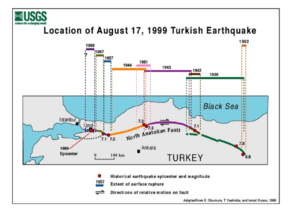Earthquake storm

Diagram showing westward progression of major earthquakes along the North Anatolian Fault
According to a recently proposed theory about earthquakes, an earthquake storm is the situation where one earthquake triggers a series of other large earthquakes—along the same plate boundary—as the stress transfers along the fault system. This is similar to the idea of aftershocks, with the exception that they take place years apart. These series of earthquakes can devastate entire countries or geographical regions. Possible events may have occurred during the end of the Bronze Age, and the latter part of the Roman Empire. It has been suggested that this is what may be occurring in modern-day Turkey.[1]
The term was coined by Stanford Professor of Geophysics Amos Nur in 2000.[2]
See also
References
- ↑ "Earthquake Storms". Horizon. April 1, 2003. Retrieved 2007-05-02.
- ↑ Amos Nur (2000). "Poseidon’s Horses: Plate Tectonics and Earthquake Storms in the Late Bronze Age Aegean and Eastern Mediterranean". Journal of Archaeological Science 27: 43–63. doi:10.1006/jasc.1999.0431.